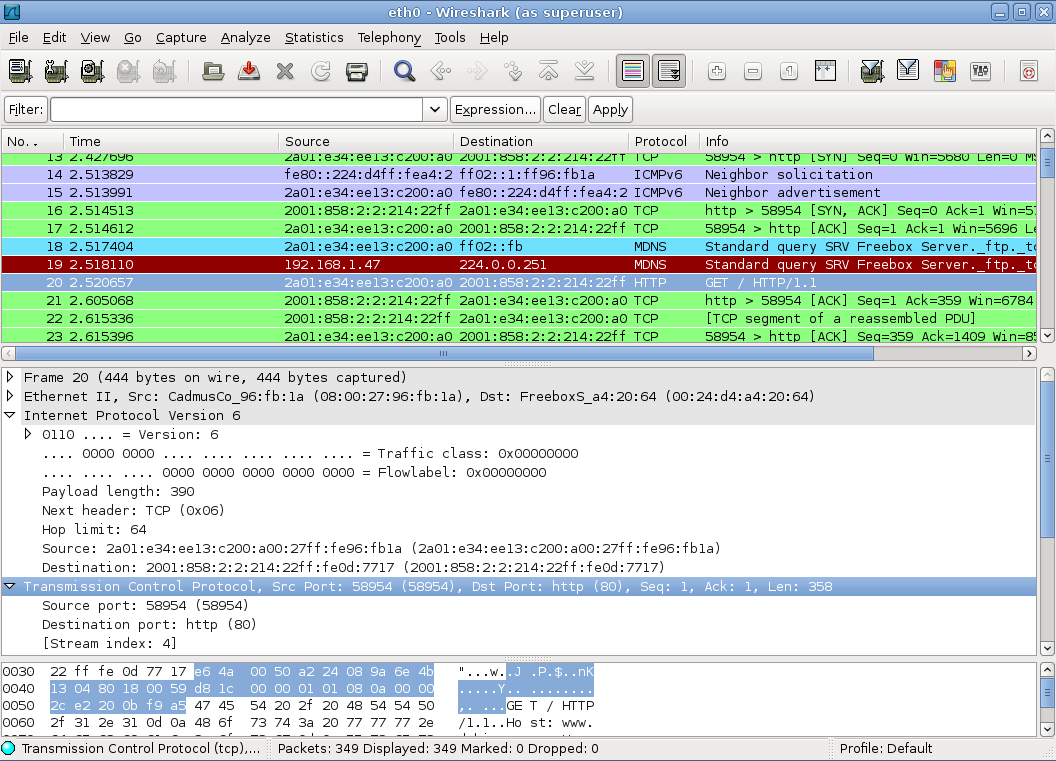

- Tcpdump wireshark how to#
- Tcpdump wireshark install#
- Tcpdump wireshark manual#
- Tcpdump wireshark trial#
- Tcpdump wireshark download#
With a little research I found that the SSL libraries for wireshark have been updated in the 3.5.0_RC available for various platforms hereĪ new installation with sshdump selected as an option is needed.įrom there with a little google-foo and trial and error I was able to capture live data from any or all interfaces. You can use tcpdump to capture packets in a remote machine that does not have a.
Tcpdump wireshark download#
The standard download of wireshark is 3.4.6 does not have the proper SSL Kex to connect with IPFire as described on the blog here One benefit of Wireshark is that it can read. I have used wireshark for various reasons over the years and I jus thought I would share how I was able to get it working for me. Once you start to collect a packet capture on all of the involved systems, re-create your problem, note the exact time of the re-create, stop the packet captures, and send the *.cap and *.pcap files collected to IBM by following the instructions in Exchanging Information with IBM Technical Support.I wanted to see real-time traffic on my interfaces and I am a new user here.
Tcpdump wireshark manual#
Tshark -i "Local Area Connection" -w capture.pcapįor more details on using tshark you can look at the tshark manual page. \Device\NPF_ (Local Area Connection)įor this example, we want to use the Local Area Connection interface, so to collect a packet capture on this interface and output it to a file of "capture.pcap", you would use the following command: This command shows an output similar to this:Ĥ. The following page from 'Windows network services internals' explains why: The missing network loopback interface. You cant capture on the local loopback address 127.0.0.1 with WinPcap.
Tcpdump wireshark install#
You can see a list of interfaces on your local machine with the following command: Starting from Wireshark 3.0.0, the Windows installer includes and will install a recent version of Npcap. If you do not provide an -i argument, the command attempts to use the first available interface, which depending on your setup might not be the correct one. The -i argument is the network interface you need to capture traffic on while the -w argument is the output file. You can run "tshark" from this directory to collect a packet by using a command such as: This program is located in your root Wireshark installation directory, which by default should be "C:\Program Files\Wireshark". The well known Ethernet type for PTP traffic is 0x88F7 Example traffic Sync Message. PTP can use Ethernet as its transport protocol. Ethernet: Starting with IEEE1588 Version2, a native Layer2 Ethernet implementation was designed. This approach is advisable if you need to remotely access the server. The well known UDP ports for PTP traffic are 319 (Event Message) and 320 (General Message).

Tcpdump wireshark how to#
For detailed steps of how to collect a packet capture in the Wireshark GUI see Using wireshark to trace network packets on Windows along with an example video walkthrough on Youtube.Īlternatively, after Wireshark is installed, you can collect the packet capture via a command-line program called "tshark". Once the packet capture is started, re-create your issue, save the packet capture, and then upload the capture to IBM Support. After installation is complete, you can start the Wireshark GUI and collect a packet capture. Note that, during the installation, you need to install Winpcap as well. You can download Wireshark from the following site:Īfter downloading Wireshark, you need to install it with administrator permissions. Thus, to collect a packet capture on Windows, you must download and install an application called Wireshark. Unlike Linux, Windows does not come with a good packet capture tool. For more details on tcpdump and other possible command-line arguments, you can look at the tcpdump manual page.

Once you have started tcpdump on a command line, re-create the issue you are seeing before stopping tcpdump, note the exact time of the re-create, and then provide the output file. You need to be logged in as an admin or root user to use tcpdump. IBM Support lets you know whether there is a specific host and port needed for packet capture. Meanwhile, if you want to only collect traffic going to or from a particular hostname and port you can use a command such as: The -w argument directs the raw packets to a cap file so that you can provide the capture to IBM Support. To collect a packet capture by using tcpdump, use a command such as: We would advise that you use tcpdump as this should already be installed on all standard Linux distributions. For details on using Wireshark, see the section "On Windows". To collect a packet capture on Linux you can either use tcpdump, which is already included in most Linux distributions or by installing Wireshark.


 0 kommentar(er)
0 kommentar(er)
